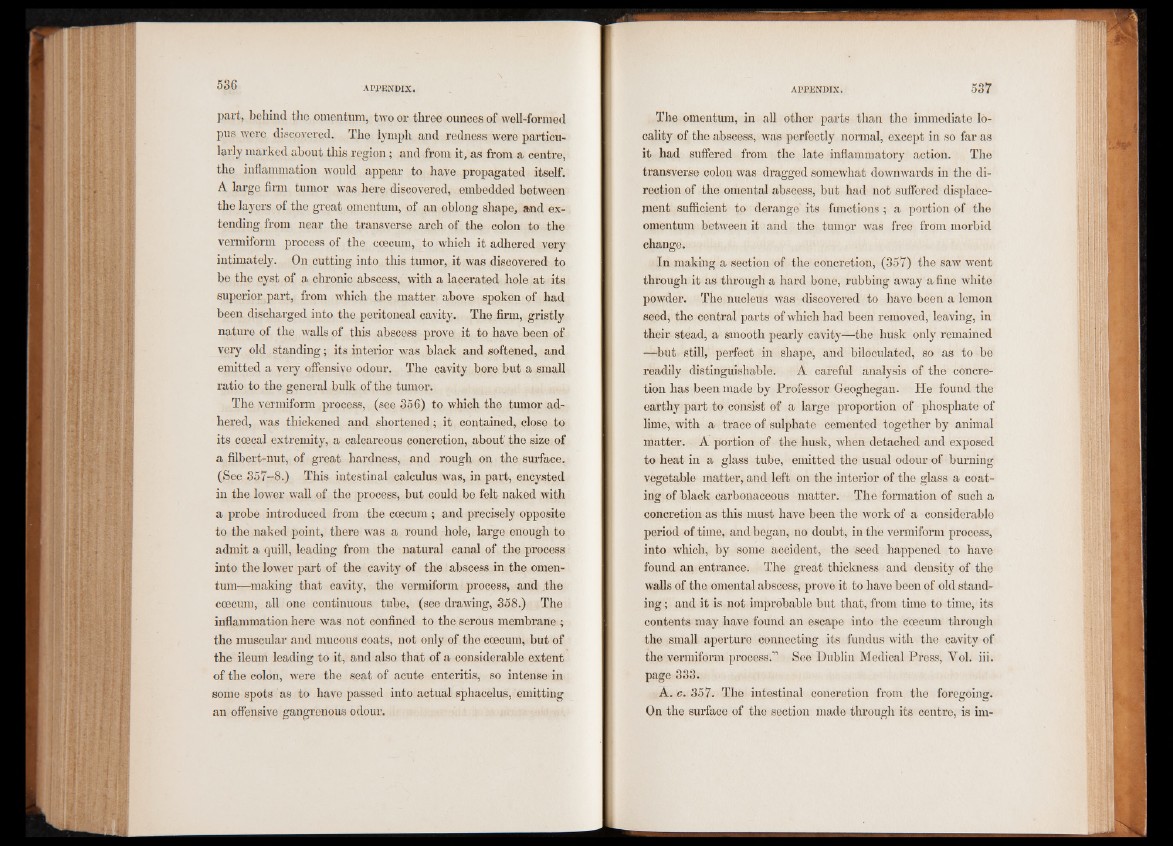
part, behind the omentum, two or three ounces of well-formed
pus were discovered. The lymph and redness were particularly
marked about this region ; and from it, as from a centre,
the inflammation would appear to have propagated itself.
A large firm tumor was here discovered, embedded between
the layers of the great omentum, of an oblong shape, and extending
from near the transverse arch of the colon to the
vermiform process of the cæcum, to which it adhered very
intimately. On cutting into this tumor, it was discovered to
be the cyst of a chronic abscess, with a lacerated hole at its
superior part, from which the matter above spoken of had
been discharged into the peritoneal cavity. The firm, gristly
nature of the walls of this abscess prove it to have been of
very old standing ; its interior was black and softened, and
emitted a very offensive odour. The cavity bore but a small
ratio to the general bulk of the tumor.
The vermiform process, (see 356) to which the tumor adhered,
was thickened and shortened ; it contained, close to
its coecal extremity, a calcareous concretion, about' the size of
a filbert-nut, of great hardness, and rough on the surface,
(See 357-8.) This intestinal calculus was, in part, encysted
in the lower wall of the process, but could be felt naked with
a probe introduced from the cæcum ; and precisely opposite
to the naked point, there was a round hole, large enough to
admit a quill, leading from the natural canal of the process
into the lower part of the cavity of the abscess in the omentum—
making that cavity, the vermiform process, and the
coeeum, all one continuous tube, (see drawing, 358.) The
inflammation here was not confined to the serous membrane ;
the muscular and mucous coats, not only of the cæcum, but of
the ileum leading to it, and also that of a considerable extent
of the colon, were the seat of acute enteritis, so intense in
some spots as to have passed into actual sphacelus, emitting
an offensive gangrenous odour.
The omentum, in all other parts than the immediate locality
of the abscess, was perfectly normal, except in so far as
it had suffered from the late inflammatory action. The
transverse colon was dragged somewhat downwards in the direction
of the omental abscess, but had not suffered displace-
jnent sufficient to derange its functions | a portion of the
omentum between it and the tumor was free from morbid
change.
In making a section of the concretion, (357) the saw went
through it as through a hard bone, rubbing away a fine white
powder. The nucleus was discovered to have been a lemon
seed, the central parts of which had been removed, leaving, in
their stead, a smooth pearly cavity—the husk only remained
—but still, perfect in shape, and biloculated, so as to be
readily distinguishable. A careful analysis of the concretion
has been made by Professor Geoghegan. He found the
earthy part to consist of a large proportion of phosphate of
lime, with a trace of sulphate cemented together by animal
matter. A portion of the husk, when detached and exposed
to heat in a glass tube, emitted the usual odour of burning
vegetable matter, and left on the interior of the glass a coating
of black carbonaceous matter. The formation of such a
concretion as this must have been the work of a considerable
period of time, and began, no doubt, in the vermiform process,
into which, by some accident, the seed happened to have
found an entrance. The great thickness and density of the
walls of the omental abscess, prove it to have been of old standing
; and it is not improbable but that, from time to time, its
contents may have found an escape into the cæcum through
the small aperture connecting its fundus with the cavity of
the vermiform process.” See Dublin Medical Press, Vol. iii.
page 333.
A. c. 357. The intestinal concretion from the foregoing.
On the surface of the section made through its centre, is im